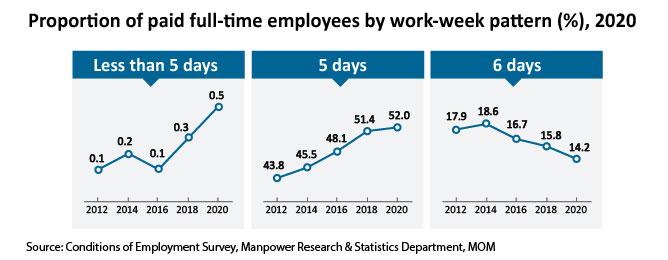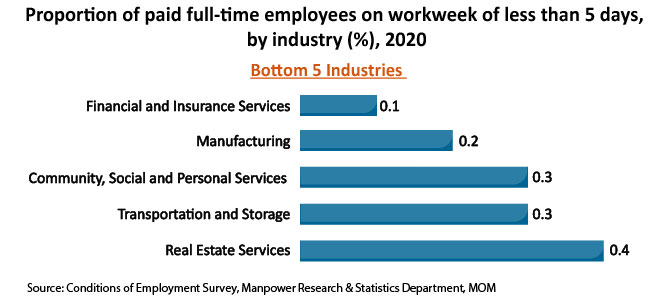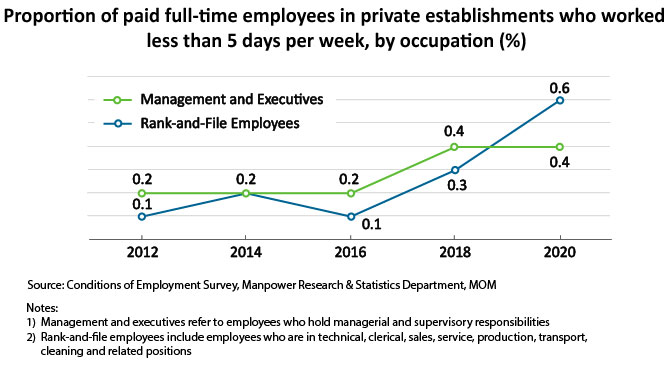Workweek pattern: Has the pandemic brought about a change in mindset about the traditional workweek?

Is the traditional workweek of 5 days, 40 hours days merely arbitrary and a social construct? It was not too long in 1926 when Henry Ford adopted a five-day, 40-hour workweek, down from 6 days a week. He believed that this would encourage workers to vacation and shop on Saturday. Here in Singapore, PM Lee announced a 5-day, 44-hour workweek, starting with the civil service at the National Day Rally in 2004. He cited a need for better work life balance, in order to have a more inclusive society. With the provision of work-life harmony programmes1, has the pandemic and technological advancements allowed us to explore options to work around the traditional workweek nearly a decade on?
Our data from the
Conditions of Employment Survey showed that over time, a higher proportion of full-time employees2 worked 5 days or less per week. In 2020, during the pandemic, 0.5% of the workforce worked less than the traditional 5 days a week, up from 0.3% pre-pandemic. Correspondingly, a smaller proportion of full-time employees was also working 6 days a week. The trend toward a shorter workweek was encouraging, as we increasingly focus on wellbeing.

The case for a shorter workweek
Is it the time for us to dissociate “traditional” work hours and task achieved? The decision on a four-day workweek remains mixed. For the burger chain Shake Shack, a trial of a four-day workweek in 2019 had come to a halt, citing their need for staff on hourly wages, while countries like Malaysia acknowledged that most SMEs employers were still not ready for the shorter workweek. On the other hand, in Iceland, trials ran by the Reykjavik City Council and the national government of 2,500 workers from 2015 to 2019 revealed that employers and employees were satisfied from the outcome of a shorter workweek, citing less stress and risk of burnout. However, issues like less facetime with frontline staff or reduction in staff strength could explain why establishments are not rushing to implement a shorter workweek. A shorter workweek might sound ideal for many employees in Singapore, but
a one-size-fits-all approach does not work. Sectors such as the
real estate services and
financial & insurance services still value services which depend on the rest days of clients, especially on weekends, making it hard to work in a “traditional” workweek.

Adapting to the pandemic with a shorter workweek
Rank-and-file employees, associated with non-PMET jobs such as cleaning and production roles, would typically lag the managers and executives in adoption rate for a shorter workweek due to the nature of their work. However, during the pandemic, 0.6% of rank-and-file full-time employees in private establishments adapted to a shorter workweek as safe distancing measures reduced physical foot traffic in food and beverage establishments, and many had to work shorter workweeks. Employers were able to redistribute work hours and lower cost due to reduced electricity and energy consumption with this arrangement, while employees could keep their jobs albeit likely with lesser pay due to the reduced workweek.
Local restaurant Candlenut put all kitchen staff on a four-day workweek as they balance work and mental wellbeing amid the punishing work hours. This change continued in the pandemic and
many establishments are now rethinking the possibility of flexible working arrangements (FWAs) like tele-working and compressed workweeks. In doing so, they hope to bring about work-life balance for employees. FWAs like compressed workweek can be an option for employees. This means a standard workweek will fit into a shorter one. In 2020, 10.2% of the establishments currently offer this arrangement to their permanent employees and employees on contract of at least one year. This was up from 3.1% pre-COVID-19 in 2018, showing that more employers now prioritize FWAs and its benefits.

Are we ready for a shorter workweek?
While mass adoption of a shorter workweek has its advantages, a possible longer workday as well as pay cuts must be factored into this consideration. An extended workday and a redundancy possibility may add to stress levels for employees. As such, TAFEP recommends every establishment to consider feasibility and suitability checks via cost-benefit analysis prior to spearheading such programmes as a shortened workweek might not be ideal for everyone. Citigroup3 Singapore’s female staff has feedbacked that the company’s compressed workweeks has allowed them to spend more time with their family. In return, the company experienced less attrition rate and greater productivity. Such an example is a win-win for both employers and employees and a positive example for other establishments in time to come. If various types of FWAs are coupled with responsible use by employees, it will result in a richer and higher quality of work.

1 This includes flexible work arrangements, leave schemes and employee support schemes
2 Full-time employees refer to employment where the normal hours of work are
at least 35 hours a week
3 Tripartite Guidelines on Best Work-Life Practices